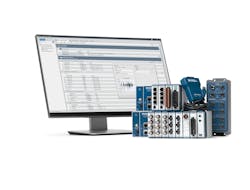The Future of Wireless Communication Starts with Today’s Test and Measurement
What foundations will 5G pave for the next generation of wireless communication? And as we build this 5G foundation, what challenges should we expect along the way?
Wireless communication is accelerating the rate in which networks, people, and devices connect to one another. As we progress to the next generation(s) of wireless communication standards, we observe a foundational relationship between each generational standard. Take, for example, foundations laid throughout the 3G era that paved the way for 4G advancements. If 3G had not made mobile internet access possible and reliable, common practices that 4G LTE enable, like real-time video calls, amateur journalism, and mobile payment, would not be possible.
So as we continue to define and refine 5G standards, pioneers in the field already have their sights set on the next generation. What foundations will 5G pave for the next generation of wireless communication? And as we build this 5G foundation, what challenges should we expect along the way?
The 5G Foundation
The 5G standard broke ground in commercial cellular communication standards by introducing and specifying operation within mmWave frequency bands and precise multi-user MIMO beamforming. Wider channels at these frequencies enable greater broadband deployments and network densification, resulting in reliable access for bandwidth-hungry applications for thousands of users in dense urban areas.
Another significant piece of this 5G foundation is the formation of ultra-reliable, low-latency communication (URLLC) and massive machine-type communications (mMTC). The 4G standard brought to light the many commercial and scientific possibilities of the Internet of Things, so it’s safe to expect that 5G’s URLLC and mMTC will greatly expand the number of interconnected devices and enable just-in-time applications that make the most out of distributed, off-premise cloud computing.
In response to this rapid increase of connected networks and devices, the search for new real estate across the radio spectrum continues. But finding more space (bandwidth) for more devices isn’t the only reason to reach beyond 5G. Another reason is to learn from the 5G standard, including any shortcomings, so that we can resolve and design solutions to these shortcomings in the next standard. This enables engineers with the capability to build upon and improve future applications.
The 6G Possibilities
Curious minds see opportunities everywhere. Ambitious minds saw opportunities to exploit the capabilities of 3G and 4G and build upon those capabilities to progress from one standard to the next. So it should come as no surprise that the engineering community will take advantage of the 6G possibilities afforded by today’s 5G standards. Take wireless cognition as an example of where 5G standards build a foundation for 6G possibilities.
Wireless cognition allows remote devices to wirelessly connect to a central computer and offload extensive data sets for which the computer can direct the devices to take complex actions. Imagine a fleet of drones that could replace traditional “wired” cameras for live events. Instead of relying on producers and camera operators to capture the perfect shot, this drone fleet, guided by a centralized computer, makes intuitive decisions to move to optimal positions within a fraction of a second. Thanks to the low-latency and high-bandwidth specifications of 5G, this concept is beginning to take shape.
As we explore the boundaries of wireless cognition within the 5G standard, we are already anticipating the limitations of 5G data rates when developing applications that mass-aggregate and distribute data to centralized computing nodes. So, if this drone fleet does not have the capability to perform contextually aware maneuvers on a 5G network, it may require the speed and reliability of a 6G network before this becomes our reality.
How do we progress to the next generation?
Progressing to the next generation of wireless communication leans heavily on our ability to design, simulate, validate, and test with both speed and accuracy—and within budget. Specifically, we need the right design, simulation, and test tools—both hardware and software—that generate and analyze these wider, more complex waveforms and disruptive improvements to the PHY, MAC, and other protocol layers above.
One of the biggest challenges in testing 5G devices is working with wider signal chains and waveforms with higher complexity. Test and measurement solutions for 4G proved insufficient to address the bandwidth and frequency requirements of 5G, as well as its increased software demands. Consequently, NI is committed to developing wideband test platforms with the right hardware and software that are able to replicate the complex uplink and downlink signals that must be tested within the 5G standard.
Another major challenge in testing 5G comes in the form of fast, accurate, and cost-effective over-the-air (OTA) testing of mmWave beamforming antennas. For engineers designing the latest phased-array beamforming architectures for 5G, traditional methods with chambers and equipment (originally designed for the aerospace and defense industry) are too slow and expensive.
New OTA approaches specifically crafted for improving the workflow of validation and test engineers in charge of these novel 5G devices are vital. As 6G researchers look to expand the frequency of operation toward the THz range, we can expect a greater need for well-designed OTA measurement solutions.
Building Tomorrow Starts Today
The future of wireless communication is connecting everyone and everything. However, progressing toward this future state depends upon the test and measurement community to ensure well-validated performance, cost-effective manufacturing, and reliable field operation for a highly integrated and complex ecosystem of 6G devices.
As 5G lays a foundation for future communication standards, we should also expect that these new aspirations continue to create new challenges for test and measurement. Engineers and research and development (R&D) organizations can overcome these challenges by investing in test solutions that not only meet today’s needs but also have the ability to evolve over time.
NI provides researchers and engineers with hardware and software platforms that can adapt as their validation and test needs become more ambitious. Making this investment paves a path toward the next standard of wireless communication.
